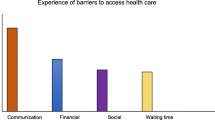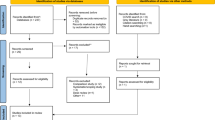Abstract
To investigate variations in explanations given for disparities in health care use between migrant and non-migrant groups, by clients and care providers in Sweden. Qualitative evidence collected during in-depth interviews with five ‘migrant’ health service clients and five physicians. The interview data generated three categories which were perceived by respondents to produce ethnic differences in health service use: “Communication issues”, “Cultural differences in approaches to medical consultations” and “Effects of perceptions of inequalities in care quality and discrimination”. Explanations for disparities in health care use in Sweden can be categorized into those reflecting social/structural conditions and the presence/absence of power and those using cultural/behavioural explanations. The negative perceptions of ‘migrant’ clients held by some Swedish physicians place the onus for addressing their poor health with the clients themselves and risks perpetuating their health disadvantage. The power disparity between doctors and ‘migrant’ patients encourages a sense of powerlessness and mistreatment among patients.
Similar content being viewed by others
Notes
‘Utlandsfödda’ is a term used both by statutory authorities and researchers in Sweden to refer people who were either born outside Sweden or were born in Sweden but have at least one parent who was born abroad [2]. ‘Infödda’are typically Swedish–born people with two Swedish- born parents. A strict translation of these terms into English may be ‘in-people’ and ‘otherland-people’, or ‘insiders’ and ‘outsiders’.
References
Social Department—The Governmental Office: the fact page. No. 14; 2007.
National Board of Health and welfare: Hälso-och sjukvård - lägesrapporter 2007. Health and health care, Current report on year 2007; 2008.
National Statistics Central Board: Ohälsa och sjukvård 1980–2005, Levnadsförhållandena Rapport nr. 113. Ill-health and health care between 1980 to 2005, Life conditions report no. 113; 2006.
Hedemalm A: Immigrants with heart failure—a descriptive comparative study of symptoms, self care, social support, care and treatment. Doctoral thesis. Gutenberg University: Sahlgrenska Academy; 2007.
Wamala S, Boström G, Akhavan S, Bildt C. Does socioeconomic disadvantage explain why immigrants in Sweden refrain from seeking needed medical treatment? Ital J Public Health. 2007;4(3):227–34.
Smedley BD, Stith AY, Nelson AR. Unequal treatment: confronting racial and ethnic, disparities in health care. Washington, DC: Committee on Understanding and Eliminating Racial and Ethnic Disparities in health care; 2003.
Abreu JM. Conscious and nonconscious African American stereotypes: Impact on first impression and diagnostic ratings by therapists. J Consult Clin Psychol. 1999;67(3):387–93.
Schulman KA, Berlin JA, Harless W, Kerner JF, Sistrunk S, Gersh BJ, Dube R, Taleghani CK, Burke JE, Williams S, Eisenberg J, Escarce JJ, Ayers W. The effect of race and sex on physicians’ recommendations for cardiac catherization. N Engl J Med. 1999;340:618–26.
Van Ryn M, Burke J. The effect of patient race and socio-economic status on physicians’ perceptions of patients. Soc Sci Med. 2000;50:813–28.
Social Department: Hälso-och sjukvård inför 90-talet, Invandrarna i hälso-och sjukvården, HS 90 (Statens offentliga utredningar, nr. 45, SOU). Helath and health care in 90-century, Immigrants in health care, HS 90 (The governmental investigations, no 45, SOU); 1984.
Sturgis P. Designing samples. In: Gilbert N, editor. Researching social life. 3rd ed. London: Sage Publications Ltd; 2008. p. 165–81.
Krippendorf K. Content analysis: An introduction to its methodology. Beverly Hills: Sage; 1980.
Patton MQ. Qualitative evaluation and research method. 2nd ed. Newbury Park: Sage; 1990.
Holme IM, Solvang BK. Forskningsmetodik—Om kvalitativa och kvantitativa metoder. Research methodology—about qualitative and quantitative methods. Lund: Studentlitteratur; 1991.
Graneheim UH, Lundman B. Qualitative content analysis in nursing research: concepts, procedures and measures to achieve trustworthiness. Nurse Edu Today. 2004;24(2):105–12.
Fiscella K, Franks P, Doescher MP, Saver BG. Disparities in health care by race, ethnicity and language among the insured: finding from a national sample. Med Care. 2002;40:52–9.
Etchason J, Armour B, Ofili E, Rust G, Mayberry R, Sanders L, Pitts MM. Racial and ethnic disparities in health care. JAMA. 2001;285(7):285–883.
Akhavan S: The health and working conditions of female immigrants in Sweden. Doctoral thesis. Stockholm: Karolinska Institute; 2006.
Ver Ploeg M, Perrin E. National research council (U.S.), Panel on DHHS collection of race and ethnicity data staff (contributor). Eliminating health disparities: Measurement and data needs. Washington: National Academic Press; 2004.
Nazroo JY. The structuring of ethnic inequalities in health: economic position, racial discrimination and racism. Am J Public Health. 2003;93(2):277–84.
Paradies Y. A systematic review of empirical research on self-reported racism and health. Int J Epidemiol. 2006;35:888–901.
Foucault M. “Body/power” and “truth and power”. In: Colin G, editor. Power/knowledge—selected interviews 1972–1977. UK: Harvester; 1980. p. 131.
Ivory JM. Self-colonization, loneliness and racial identity in Ama Ata Aidoo’s our sister Killjoyor reflections form a black-eyed squint. In: Japtok M, editor. Postcolonial perspectives on women writers from Africa, the Caribbean, and the U.S. Trenton: Africa World Press; 2003. p. 249–74.
Said EW. Orientalism. New York: Pantheon; 1978.
McLeod J. Beginning post-colonialism. Manchester: Manchester University Press; 2000.
Misztal B. Trust in modern societies. Cambridge: Polity Press; 1996.
Kai J, Beavan J, Faull Ch, Dodson L, Gill P, Beighton A. Professional uncertainty and disempowerment responding to ethnic diversity in health care: a qualitative study. PLoS Med. 2007;4(11):1766–75.
Regmi K, Naidoo J, Pilkington P. Understanding the processes of translation and transliteration in qualitative research. Int J Qual Methods. 2010;9(1):16–26.
Acknowledgments
The authors wish to thank all participants in this study; without their contribution it would not have been possible to undertake the research. Thanks to research assistant Sabina Adamsson. The study was supported by the Research Center Skaraborgs Institutet.
Author information
Authors and Affiliations
Corresponding author
Rights and permissions
About this article
Cite this article
Akhavan, S., Karlsen, S. Practitioner and Client Explanations for Disparities in Health Care Use Between Migrant and Non-migrant Groups in Sweden: A Qualitative Study. J Immigrant Minority Health 15, 188–197 (2013). https://doi.org/10.1007/s10903-012-9581-y
Published:
Issue Date:
DOI: https://doi.org/10.1007/s10903-012-9581-y




